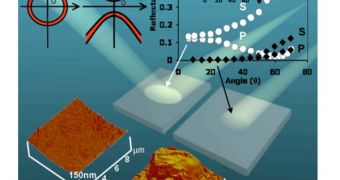A group of investigators at the Purdue University, led by expert Evgenii Narimanov, announces the development of a new type of metamaterial that is capable of absorbing much more light than any competitor on the market today. To a casual observer, the material appears extremely black.
The most potent black dyes coating materials absorb about 80 percent of the entire amount of photons that strike it. This is absolutely essential to remember when it comes to understanding how colors form.
The more light a material absorbs, the darker its color. Materials that reflect the vast majority of photons back towards their source appear white, researchers explain. The newly-developed metamaterial appears to be blacker than the purest black.
A metamaterial is a synthetic material that is engineered specifically for a certain application. For example, researchers may use it to harness light, forcing photons to be diverted around an object that needs to be concealed. This is the basic principle of an invisibility cloak.
Researchers at Purdue University are renowned for their work on metamaterials, and for the many breakthroughs they managed over the year. The new material, for instance, has tremendous applications in the field of renewable energy.
It could be used to create a new generation of solar cells that could use both light and heat for energy production. Because it absorbs such a high proportion of the light that hits it, the material understandably becomes very hot.
By employing heat-harvesting devices on the surface of the new solar cells, physicists may be able to boost the amount of electricity that can be produced from a single solar panel. The researchers say they used a hyperbolic metamaterial for this research.
What the team managed to achieve is a nearly 20 percent improvement in the amount of light materials can trap. The novel metamaterial reflects less than 1 percent of incoming light back towards its source.
A prototype device made based on the new technology looks like a simple slab. However, its surface is covered by massive numbers of silver nanowires, which are grown in an aluminum oxide membrane.
At this point, the team plans to conduct additional investigations into the structure of their new material. The work could result in the creation of even more advanced hyperbolic metamaterials, Technology Review reports.

 14 DAY TRIAL //
14 DAY TRIAL //